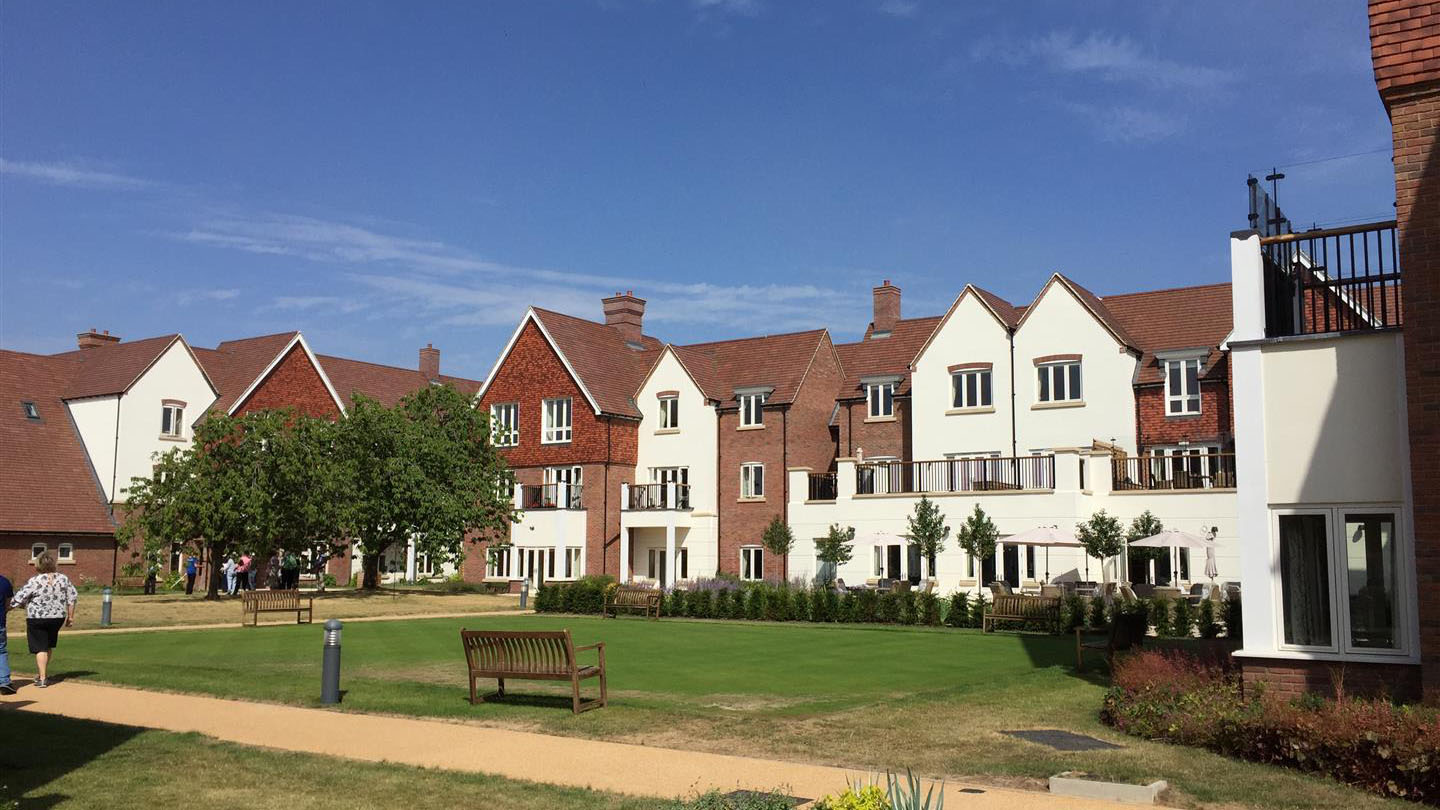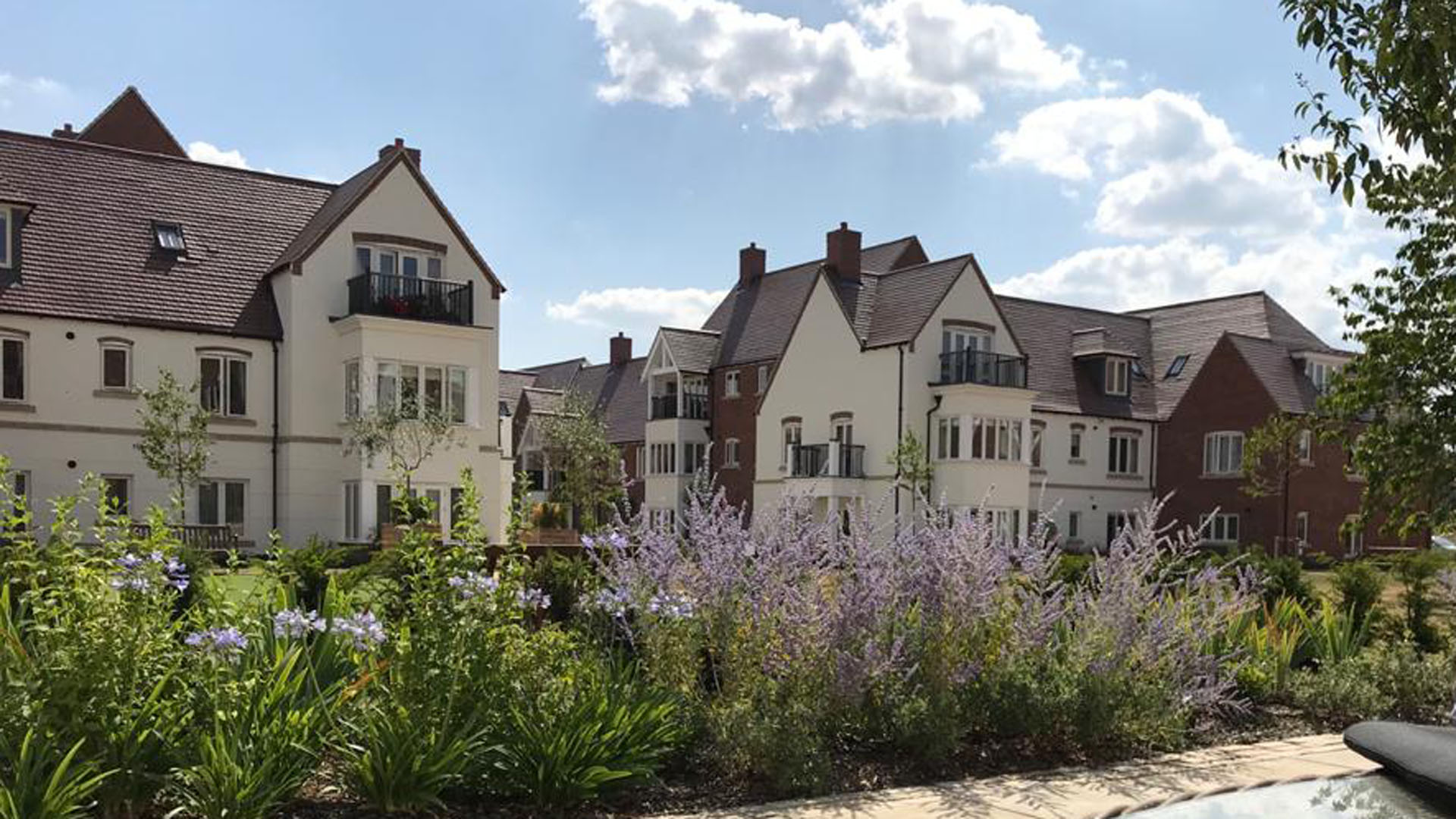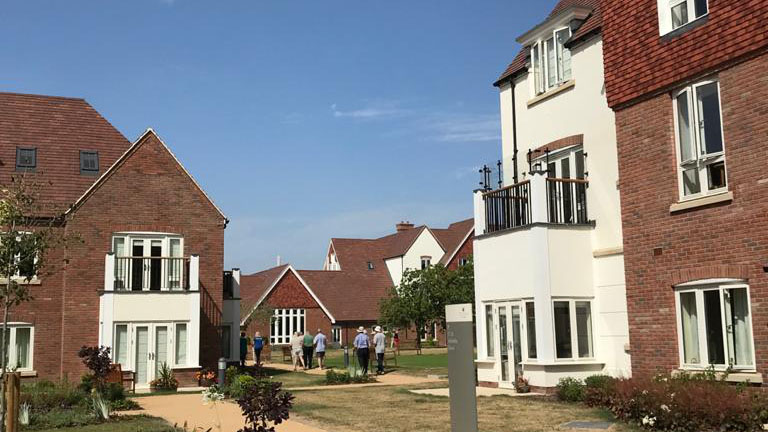National Apprenticeship Week, T-Level Thursday
On T-Level Thursday we look back at the development at North Hertfordshire College in Stevenage. ...
Wide
Standard
Large Tablet
Small Tablet
mobile



Dispel the image of older people shuffling around isolated areas miles from anywhere; waiting for a bi-monthly tea with friends in a tired community hall. A retirement village, considered an extension of the extra care housing concept can offer far, far more. Saunders Senior Living designer, Robin Callister investigates
Living in your own home, enjoying the freedom of independence, with care and support on hand if needed. This is the positive solution for seniors who want to be part of a community and call on professional assistance as required. It’s called a retirement village.
As we grow older, we don’t consider being anything other than independent for as long as possible, maintaining an active, high quality of life surrounded by family and friends. Being realistic, however, it is more than likely that most of us will need some form of care as the years progress and as analysis is showing, for some of us accessing this support may bring with it a feeling of social isolation and loneliness as our mobility and cognitive functions diminish.
What can we do to help people retain their independence AND have access to all the support they need? As an architect specialising in homes for our aging population who may or may not (yet) have additional care needs, I believe that there is already an alternative to the current options: staying in our own home until ill-health forces us into a care home or hospital, or moving into sheltered accommodation. This alternative is the ever-successful retirement village model - a way of offering high levels of care and support for people living independently in their own, future-proofed homes, surrounded by like-minded people with opportunities to integrate within a community. This is a model that appears to be attractive to older people from a range of socio-economic backgrounds (1) and offers many advantages, which I will explore further.
What is a retirement village?
Dispel the image of older people shuffling around an isolated area miles from anywhere; waiting for a bi-monthly tea with friends in a tired community hall. A retirement village, considered an extension of the extra care housing concept, offers far, far more. Think of it more as a ‘new’ village, located close to an existing village or town, built and maintained with pride and care. Here there are a range of housing options - from independent living houses and apartments, to homes with disabled access, extra care facilities and even a care home - all built around a central hub where you can find a health club, GP surgery, treatment rooms, restaurants and cafes, swimming pool and even a spa.
This is a purpose-built, community-based scheme that seeks to simultaneously fulfil housing, care and support needs while promoting independence and facilitating ageing-in-place (2). The concept aligns with current government policy to manage the financial implications of an aging population and find new ways to furnish the growing demand for care and meet the goal of enhancing the quality of life through independence and choice in housing and how care is provided (3).
The retirement village concept is a relatively new way of providing homes for older people in the UK. Whilst the first retirement village was built here around thirty-five years ago, this model is far more popular in the Netherlands and the US. Yet the idea is widely recognised as a beneficial way of living and it’s popularity is increasing in the UK. If funding can be secured, it appears to be a cost-effective way for councils and developers to meet the growing demand for homes and for care.
The village’s first and foremost goal is to provide private, self-contained homes owned by individuals in a care setting with on-hand assistance. This bestows choice on individuals, allowing them to make the decision to move to such a setting, and importantly a choice about when to move; a decision that historically is made when a life-changing event forces a decision, which usually leads to reduced choice. Individuals may choose to move into a village at any time after retirement and, therefore, may access any support they may need, as and when they choose. If support is needed, the required services can be delivered in an older persons’ own home - increasing privacy and comfort and also retaining independence. Importantly, moving to a retirement village mitigates the need to move home again later in life and it reduces the risk of deterioration in health caused by loneliness or lack of care, which is often the case when people stay in their family home, isolated from services and friends. If, as time passes, any additional or specialist support is needed, an individual can move into the onsite specialist care home, meaning that they can retain local friendships and enjoy continuity of care from trusted professionals.
Numerous health and financial benefits
There are numerous health and financial benefits for individuals and the local community from establishing a retirement community, not least because the village is a place to live, rather than simply a care setting. By siting the village near existing homes and providing a range of amenities, including the aforementioned swimming pool, spa, restaurant, landscaped gardens, function rooms and so forth, local people can be attracted to the development to join in events and connect with the residents. This interaction is important to boost inclusiveness and expand the feeling of community.
Care villages also add to the local economy. Staff are needed to maintain the property and gardens, to offer catering, security and other lifestyle services such as hairdressing, in addition to support and medical staff, and all these roles can be filled by those living in the local area. When staff live locally, it is possible to offer flexible care and have a core team of care staff that can cover each other during holidays or sickness: these are people who are known to residents, are trusted and it can mean that everyone builds real friendships - something that is so crucial to fulfilment in later years.
As I design any retirement home, it is imperative to ensure that homes are future-proofed, bearing in mind potential support needs. Elements such as accessible bathrooms, level access, and general circulation considerations ensure that all residents can retain their independence as long as is possible, regardless of failing mobility – maintaining this independence is a reason that many village residents cite as of key benefit to moving to a retirement village. It’s easy to equate independence with staying in the family home, yet ironically, this is often not the first choice of the individual concerned, rather they are staying there through lack of other options. Indeed, a lot of retro-fitting of the current housing stock to enable ‘disabled access’ as an occupier’s health fails is difficult, expensive and, in many cases, destructive and irreversible. Much of the care stock in the UK is also dated and rapidly becoming unsuited to modern living or for people with physical or sensory impairment (4) and if care needs increase, residents are forced to move anyway. In comparison, retirement villages are a positive choice - they offer a fulfilling combination of independence and security, as well as opportunities for social engagement and an active life. Whilst we never know what life will throw our way, in a village we can be assured that we can stay in our own homes and personal space as long as is possible in a manageable environment with help on hand - to maintain the property, as well as support physical and mental needs.
One of the key findings from studies of retirement village residents is that a large proportion of them avoid the negative experiences of isolation and loneliness. A study concluded that 82% of village residents have never felt isolated living there and many never felt lonely at all (5) as there is always someone around to talk to, communal areas are on the doorstep, locals mingle with residents, and many villages have bookable family rooms so that children and grandchildren can visit whenever they wish - often onsite playgrounds amuse visiting children. Doctors have known for some time that loneliness is bad for the mind. It can lead to a deterioration of mental health and be a cause of problems such as depression, stress, anxiety, and a lack of confidence. There's growing evidence that social isolation is connected with an increased risk of physical ill health as well.
Of course, all this translates into financial benefits for the state too. When we have a sense of wellbeing, and the support we need at the correct time, it is less likely that issues will develop to the point where we need serious medical intervention. We’ve all seen the numbers in the news - as a nation, the cost for social support is increasing year-on-year due to our ageing population and increased costs. By strategically placing support services for older people in a centralised place, such as inside the retirement village, we are able to reap economies of scale, enabling amenities such as a pool and gym, as well as care services, that would not be viable in a smaller development. It is easier to tailor a package of care for each resident ensuring that everyone receives exactly what they need when you can pick from a variety of onsite options along with community health services. It may be argued, this will save time and money as GPs, community nurses, and other community support people can visit more than one patient within the village during one trip.
Of course, it is really important to ensure that the villages are accessible to people with a range of financial resources by offering a mix of tenures. Properties may be bought outright from finance raised by selling the family home, for example. Others may be purchased through a help-to-buy scheme or be offered as shared ownership, or even the option to purchase a lease at a reduced price, a lease that is passed back to the village developer rather than being passed onto the owner’s beneficiaries. This mix of tenure ensures a good blend of residents, important to any community.
Another consideration is that there has to be a financial incentive for developers to adopt this model. As over-65s will make up almost a quarter of the population in the next 15 years with many being keen to downsize and liquidate assets, there is a clear demand for every type of tenure for people from a very wide socio-economic background. Developers will also benefit from phased delivery - by building standalone groups of homes and amenities, rather than these all being housed in one building, developers can fund successive phases once the first phase has sold. This is in sharp contrast to other development models whereby only capital-rich developers can get involved due to a delayed return on investment.
Village living seems like a great idea - why aren’t we building more of them?
There are challenges to every proposed senior living concept, but as an architect, I see three main issues to overcome before a successful retirement village can be created.
Location.
We need sites that are adjacent to existing towns and villages so that people remain part of a community and there is a clear catchment for staff and prospective residents. These sites can be difficult to find and if a potential site is sourced, locals can be resistant to development. The solution is to explain the benefits to all parties - the older people in the community do not have to leave the area and local residents may have enhanced opportunities for work and leisure by accessing amenities such as the pool, sauna, restaurant or gym. We envisage all members of the community sharing activities such as musical evenings or crafts with the ultimate aim to make the retirement village an integral part of the community, not separate from it.
Planning.
There is huge value in this model, as I have outlined in this paper, yet planning policy has not kept up with the retirement village concept. For example, a retirement village with its emphasis on independent home living is usually reviewed under residential policy not care sector policy. This throws up multiple obstacles and will continue to do so until this model finds its own sector and policies catch up: for example, the criteria for services such as parking and refuse collection. By its very nature, a retirement village combines both care and residential needs, for example, staff are needed to run the central amenities and the on-site care home, and these staff need parking. However, when a village is reviewed as residential rather than a managed care setting, the requirements for refuse collection, parking and amenity outside of a C2 category use are not wholly suitable. Local authorities, that tend to be rural simply by nature of land availability for this type of development, are yet to employ clear policies pertinent to retirement villages with independent living accommodation.
Design.
The architect’s biggest challenge is to design an environment that feels welcoming and homes that are comfortable despite being future-proofed, pragmatic, and safe. We need to expertly deliver a design that suits the developers’ economic strategy for accommodating a large number of resident rooms, yet which allow for care needs and care provision - such as wheelchair accessibility, ease of surveillance by staff - and at the same time ensuring that the communal and living space does not feel clinical as it will be used by a range of residents including able-bodied, those receiving palliative care, and those living with disability or dementia.
The design of the main ‘hub’ building, where the amenities will be housed, needs to delight and be functional for independent residents. These residents understandably do not want cues of them being in a care setting as they socialise in the café, bar, spa and treatment in the central hub. This means that the design needs to be more hotel-like in nature, with an almost demographic-neutral feel. This space needs to be clearly separate from the day-to-day care experienced by the care home residents and the more utilitarian requirements for the back-of-house functions.
My challenge is to create a retirement village to be lived in and enjoyed as an aspirational lifestyle and I’ve found that a successful scheme almost hides its care pedigree, despite the support that is available on site.
Conclusion
Retirement villages really can and do satisfy the requirements of older people, the state, and care providers in multiple ways. They enhance older people’s choices for independent living, they are accessible and affordable for a wide range of socio-economic groups, and they support the government’s vision of enhancing choice and quality of care services. They reduce the impact on local health and social services, ensuring that older people remain part of a thriving, local community and offer developers the benefit of creating larger developments, and operators with resultant economies of scale and the amenities and service this allows (6).
This is before we even consider the release of 100’s of under-occupied properties back onto the wider market as residents move from their home into a village, or the reduced hospital stay times due to being able to offer early release back into the professional care of a village.
It’s important that there is an alternative to the traditional housing options for older people and I believe that retirement villages are the way forward.
(1) Croucher et al (2003), Bernard et al (2004)
(2) Callaghan & Towers (2014) cf Department of Health (2005), Riseborough & Fletcher (2008)
(3) Callaghan & Towers (2014), Atkinson et al (2014)
(4) Joseph Rowntree Foundation (2006)
(5) The International Longevity Centre. Beech (2015)
(6) Joseph Rowntree Foundation (2006)
On T-Level Thursday we look back at the development at North Hertfordshire College in Stevenage. ...
On National Apprenticeship Week we celebrate the successes of Jonah Howley, Benjamin Howells and Alberte ...
We wish you peace & prosperity for the year ahead. Enjoy the time off to ...
Saunders are committed to helping young people on their architectural career paths. Over the last ...
Saunders are delighted to be speaking at the Hertfordshire Chamber of Commerce Sustainability Conference on ...
Saunders have built a strong relationship with the University of Hertfordshire, Department of Architecture. Members ...
Saunders have just received Full Planning approval for a substantial landscape led 3 level bespoke ...
A new apartment development designed by Saunders received a resolution to grant planning last night ...
We use cookies to ensure that we give you the best experience on our website. If you continue without changing your settings, we'll assume that you are happy to receive all cookies from this website. If you would like to change your preferences you may do so by following the instructions here.